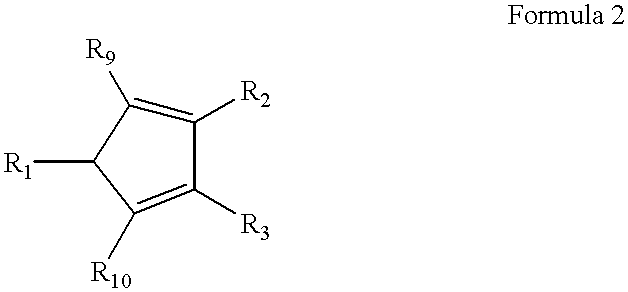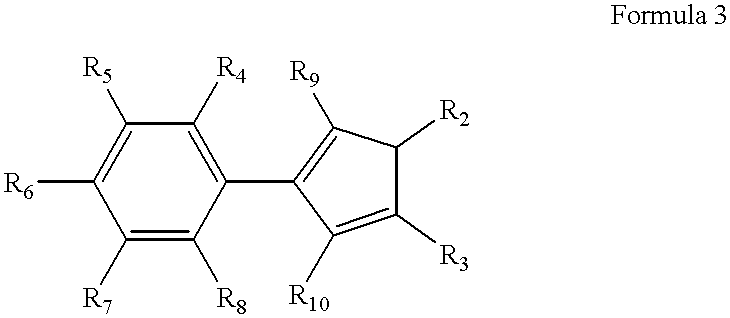High-melting polyolefin copolymer elastomers, catalysts and methods of synthesis
a technology of polyolefin and copolymer, which is applied in the direction of physical/chemical process catalysts, organic-compounds/hydrides/coordination complex catalysts, physical/chemical process catalysts, etc., can solve the problem of limiting high temperature performan
- Summary
- Abstract
- Description
- Claims
- Application Information
AI Technical Summary
Benefits of technology
Problems solved by technology
Method used
Image
Examples
example 1
Preparation of 2-(bis-3,5trifluoromethylphenyl)indene (Ligand A)
A 3-neck 500 mL round-bottomed flask fitted with a condenser and an addition funnel was charged with 2.62 g (0.11 mol) of Mg turnings and 20 mL of anhydrous diethyl ether. Slow addition of a solution of 25.10 g (0.09 mol) of 3,5-bis(trifluoromethyl) bromobenzene in diethyl ether (100 mL), followed by refluxing for 30 min, gave a brown-grey solution of the aryl Grignard reagent. The solution was cooled to room temperature (RT), filtered over a plug of Celite and evacuated to yield a brown oil. Toluene (40 mL) was added and the suspension cooled to 0.degree. C. whereupon a solution of 2-indanone (9.22 g, 0.07 mol) in toluene (60 mL) was added dropwise to give a tan-brown slurry. This mixture was warmed to room temperature and stirred for an additional 3 hours. After cooling to 0.degree. C. it was quenched with 150 mL of water, hexane (200 mL) added and the reaction mixture neutralized with 5M HCl. The organic layer was se...
example 2
Preparation of Bis(2-(bis-3,5-trifluoromethylphenyl)indenyl) zirconium dichloride, (Metallocene 4)
N-Butyllithium (2.5 M in hexanes, 0.850 mL, 2.13 mmol) was added to a solution of 2-(bis-3,5-trifluoromethylphenyl) indene (648 mg, 1.97 mmol) in toluene (15 mL). The heterogeneous solution was stirred at ambient temperature for 4 hours 30 minutes to give a green-yellow solution which was treated with a suspension of ZrCl.sub.4 (240 mg, 1.03 mmol)in toluene (20 mL) via cannula. The yellow suspension was stirred at room temperature for 2.5 hours, heated to ca. 80.degree. C., and filtered over a plug of Celite. After washing the Celite with hot toluene several times (3.times.10 mL), the filtrate was concentrated and cooled to 18 C. to give 442 mg (55%) of light yellow crystals of Bis(2-(Bis-3,5-trifluoromethylphenyl)-indenyl)zirconium dichloride. .sup.1 H NMR (C.sub.6 D.sub.6, 23 C., 400 MHz): d 7.67 (s, 2H, Arf), 7.55 (s, 4H, Arf), 7.19 (m, 4H, Ar), 6.89 (m, 4H, Ar), 5.96 (s, 4H, C.sub.p...
example 3
Preparation of Bis(2-(bis-3,5-trifluoromethylphenyl)indenyl) hafnium dichloride, (Metallocene 5)
N-Butyllithium (1.6M in hexanes, 2 mL. 3.20 mmol) was added dropwise at room temperature to a solution of 2-(bis-3,5-trifluoromethylphenyl)indene (1.03 g. 3.14 mmol) in diethyl ether (10 mL). After stirring for 30 min, the solvent was removed in vacuo leaving a green-yellow solid. In a drybox, HfCl.sub.4, (510 mg, 1.59 mmol) was added to the lithium salt. The solids were then cooled to -78.degree. C. at which temperature toluene (45 mL) was slowly added. The flask was allowed to reach ambient temperature and the suspension was stirred for 24 hours after which time it was heated for 15 min to ca. 80.degree. C. (heat gun). The solvent was then removed in vacuo. The solid was extracted with CH.sub.2 Cl.sub.2 (50 mL) and the solution filtered over a plug of Celite. After washing the Celite with 4.times.15 mL CH.sub.2 Cl.sub.2, the solvent was removed in vacuo from the filtrate. The solid was ...
PUM
| Property | Measurement | Unit |
|---|---|---|
| mole fraction | aaaaa | aaaaa |
| mole fraction | aaaaa | aaaaa |
| mole fraction | aaaaa | aaaaa |
Abstract
Description
Claims
Application Information
 Login to View More
Login to View More - R&D
- Intellectual Property
- Life Sciences
- Materials
- Tech Scout
- Unparalleled Data Quality
- Higher Quality Content
- 60% Fewer Hallucinations
Browse by: Latest US Patents, China's latest patents, Technical Efficacy Thesaurus, Application Domain, Technology Topic, Popular Technical Reports.
© 2025 PatSnap. All rights reserved.Legal|Privacy policy|Modern Slavery Act Transparency Statement|Sitemap|About US| Contact US: help@patsnap.com



